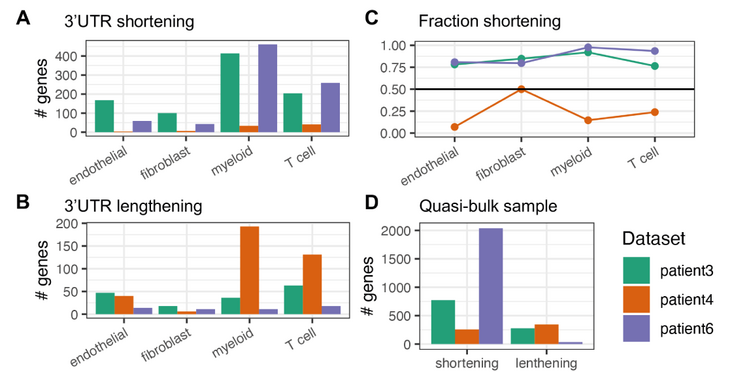The Zavolan lab developed a new computational tool for the analysis of alternative 3'-UTRs called SCUREL and used it to analyse data of human lung adenocarcinoma. The corresponding publication "Shortening of 3' UTRs in most cell types composing tumor tissues implicates alternative polyadenylation in protein metabolism " has been published in RNA.
Abstract
During pre-mRNA maturation 3’ end processing can occur at different polyadenylation sites in the 3’ untranslated region (3’ UTR) to give rise to transcript isoforms that differ in the length of their 3’UTRs. Longer 3’ UTRs contain additional cis-regulatory elements that impact the fate of the transcript and/or of the resulting protein. Extensive alternative polyadenylation (APA) has been observed in cancers, but the mechanisms and roles remain elusive. In particular, it is unclear whether the APA occurs in the malignant cells or in other cell types that infiltrate the tumor. To resolve this, we developed a computational method, called SCUREL, that quantifies changes in 3’UTR length between groups of cells, including cells of the same type originating from tumor and control tissue. We used this method to study APA in human lung adenocarcinoma (LUAD). SCUREL relies solely on annotated 3’UTRs and on control systems, such as T cell activation and spermatogenesis gives qualitatively similar results at much greater sensitivity compared to the previously published scAPA method. In the LUAD samples, we find a general trend towards 3’UTR shortening not only in cancer cells compared to the cell type of origin, but also when comparing other cell types from the tumor vs. the control tissue environment. However, we also find high variability in the individual targets between patients. The findings help to understand the extent and impact of APA in LUAD, which may support improvements in diagnosis and treatment.
Read the Publication in RNA (Open Access)
Abstract, figure and title from Burri and Zavolan (2021) RNA published under a CC BY 4.0 license.
